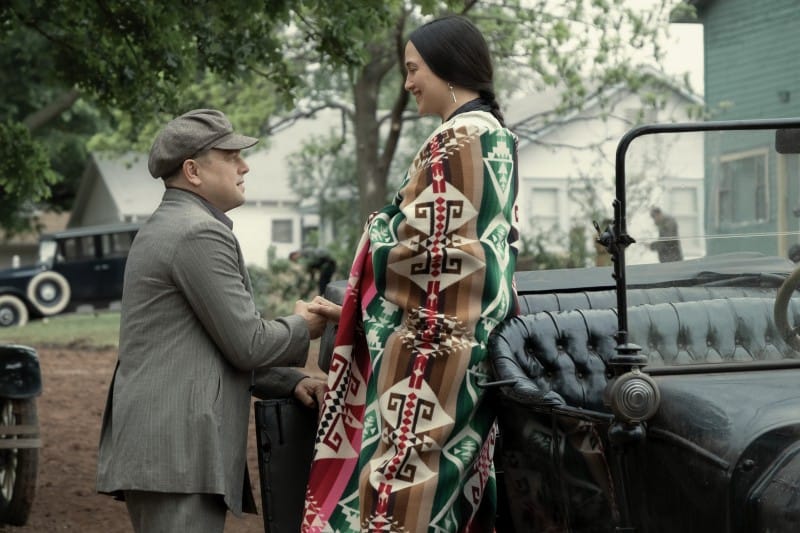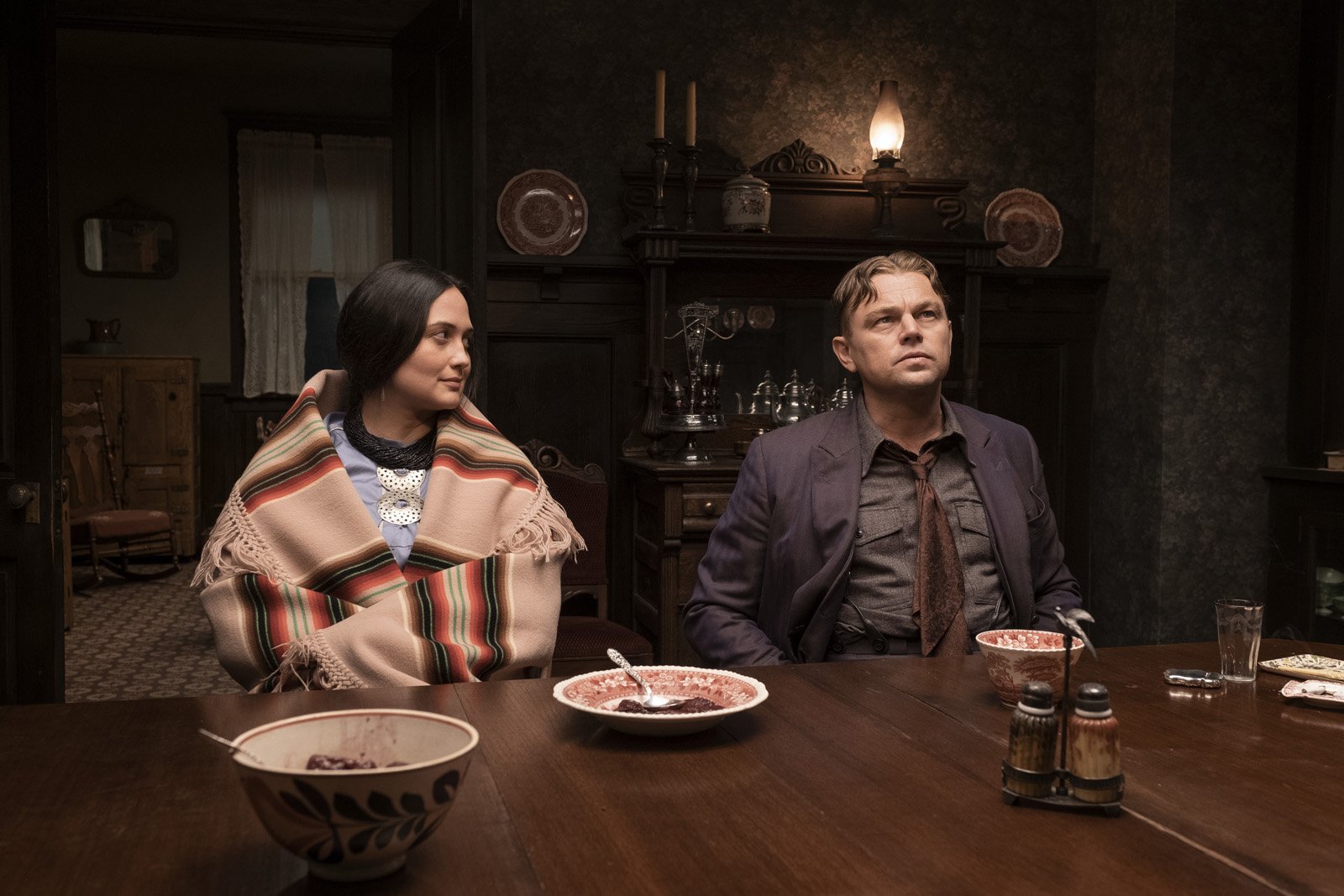I saw The Killers of the Flower Moon yesterday.
The masterful, 3 hour and 27 minute film from Martin Scorsese simultaneously disturbed and enlightened. It is a paean to a century before, an homage to a time long ago, and a morality tale about greed, based on the 2017 book of the same name by David Grann.
Scorsese crafted an elaborate framing device, in which the viewer is brought back into the 1920s. He used old-timey black & white vintage footage (newly filmed, of course) which displays a number of richly ornamented Native Americans gallavanting through the town of Fairfax, Osage County, Oklahoma, showing up their bling, stylishly posing for the cameras, and driving their Studebakers—or rather, being driven by their chauffeurs. Enter the Osage: a Native American tribe whose relocation to a reservation whose land was previously deemed worthless until the discovery of natural oil. Scorsese cuts to a scene depicting several Osage braves enjoying an oil-drenched dance under a geyser of the bubbling brew. Scorsese intercuts the old-style title cards, or intertitles, appropriated from the silent film era, explaining how the Tribe benefitted from the oil boom, resulting in the wealthy Indians above.
Enter the white man. We see several examples of obese hucksters trying to disenfranchise the Osage from their money, offering them expensive photographs, sham insurance deals, and generally any other shady way to steal their guaranteed oil money. Of the photographs, we see a couple take up the offer, and Scorsese privileges us with several of these historically preserved photographs of Osage Indians posing for the camera, in their spiffiest Western best. Our heroine (played by indigenous Montana actor Lily Gladstone) also appears in one, doubtlessly photoshopped onto an older photograph. The boomtown 1920s are in full swing.
We see Leo DiCaprio, in the huckiest (like huckster-hillbilly-golly-gee-shucks) role we've ever seen him in, exit the train for town, and proceed to watch, and throw a few punches in, some drunken brawl—until his Indian accomplish taps him on the shoulder, and brings him to the car. Darn, Leo was just getting use to the local scene.
For much of the movie, we see wide-eyed Leo imbibing everything around him like a kid's first time at a circus. The brawls, the street races, the scam artists, the money. It's all so exciting and new to him!
He is taken to meet his uncle, who wants Leo to address him as the King,
just as he did as a child. The uncle, William King
Hale, is quite the local magnate around town, financing schools, hospitals, and public works. He promises to take Leo (his name is Earnest Burkhardt) under his wing, and show him the ropes.
Leo's first job is as a cab driver, a chaffeur, but driving Studebakers. He picks up his soon-to-be love interest Miss Molly Kyle, an Osage beauty whom apparently many a man had his eye on. After three rides, Earnest is smitten by Molly, and apparently vice versa. She invites him into her house, she makes him some pudding, and they spend the rest of the evening sizing each other up while smoking and listening to the sound of the rain on the roof.
Apparently, however, the King has some interest in Leo (*cough* Earnest) settling down with Molly. After all, she has is one of four sisters who are all full-blood Osage, with all the oil rights and benefits that entails (*cough* money).
I won't ruin the rest of the plot for you, but essentially in the rest of the movie, we see Leo become a sort of Wolf of Oke Street.
(At several points, we hear Leo say, I do love me my money
, in a manner not unlike Brad Pitt's Lt. Aldo Raine, I do want me my Nazi scalps!
.) By the time we're done, we're not sure whom to believe, who to trust; was Leo purely motivated by greed and evil, or were his actions manipulated by those around him? Apparently, Scorsese would have had the time run a lot longer, but — and this is one of the differences between the book and the film — he did not want the film to become like a police procedural/courtroom justice epic.
The film ends with the framing device of a cast of voice actors in the 1960s narrating to an enthralled audience, in Garrison Keillor-Praire Home Companion-style, what happened to each of the characters. We are shocked, we are disturbed; like the audience of the true crime
mystery theatre, we are enthralled, we want to know more. But that's the point: maybe some of these things can never be explained.
I understand that delving into uncomfortable aspects of American history might not be everyone's cup of tea. However, The Killers of the Flower Moon
offers far more than just a recounting of past injustices. The book, and the film, is a compelling narrative that transcends history; it's a captivating tale of mystery, conspiracy, and the birth of modern investigative techniques.
At its core, this book is a gripping true crime story, filled with intriguing characters, suspenseful plot twists, and a gripping quest for justice. David Grann, and Martin Scorsese, skillfully weaves together multiple narratives – the Indian murders, the birth of the FBI (called here the Bureau of Investigation), and the pursuit of truth – making it read like a gripping thriller rather than a typical historical account.
Picking up this narrative, you're not just confronting the uncomfortable past; you're also witnessing the evolution of law enforcement and investigative methods. The story, whose criminal justice side is more transparent in the book, introduces you to real-life heroes like Tom White, an FBI agent who navigates through a maze of deceit and corruption to bring justice to the victims and their families.
Moreover, The Killers of the Flower Moon
prompts reflection on broader societal issues, encouraging readers to consider the implications of historical injustices on present-day circumstances. It provides an opportunity to better understand the complexities of American history and how these events have shaped our society today.
Reading this book offers a chance to broaden your perspective, fostering empathy, understanding, and a deeper appreciation of the struggles faced by marginalized communities. It's not just about confronting uncomfortable truths; it's about gaining insight, empathy, and a more profound connection to the shared human experience.
In essence, The Killers of the Flower Moon
isn't solely about the discomfort of history; it's about the intrigue of a compelling story, the pursuit of justice, and the lessons we can draw from the past to create a better future. It's a captivating journey that will leave you informed, moved, and with a renewed appreciation for the power of uncovering hidden truths.
You can find the book here.
Killers of the Flower Moon; try it here at Kittl.
Leonardo DiCaprio, Martin Scorcese, Wolf of Wall Street, Killers of the Flower Moon, Inglorious Basterds, Brad Pitt, Quentin Tarantino, Robert DeNiro,Money, Greed, Survival, Osage Indians, Fairfax, Osage County, Oklahoma, Lily Gladstone, indigenous representation



